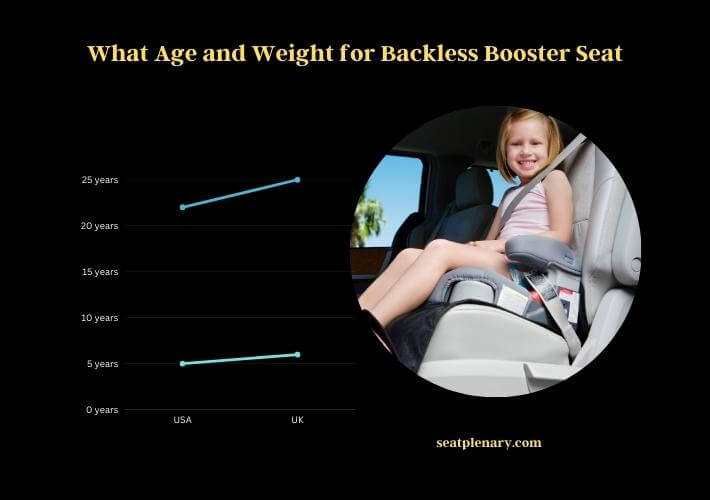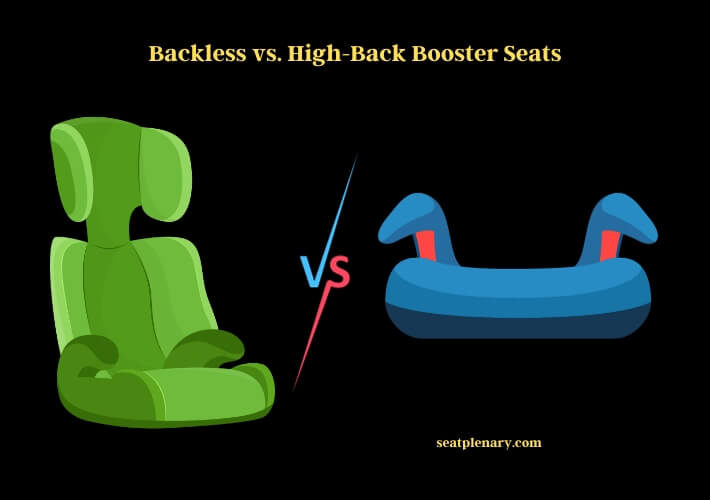For a backless booster seat, the recommended age and weight are typically around five to six years old and at least 22kg (3 stone 6.5 pounds).
Backless booster seats have specific requirements to ensure the safety of children. These requirements revolve mainly around the child’s weight and height. The primary weight requirement for a backless booster is usually a minimum of 22kg. This weight ensures that the seatbelt fits correctly over the child’s shoulder and lap, providing maximum protection in the event of an accident.
In terms of age, many experts suggest that children should be at least five to six years old before transitioning to a backless booster. This recommendation is based on the average physical development of children and their ability to sit properly without the additional support of a high back. Speaking of which, there’s a debate between the use of backless booster seats and high back booster seats. While backless boosters are more portable and convenient, high back boosters provide additional head and neck support, especially for younger children.

The United Nations has expressed concerns about the safety of backless boosters for smaller children. As a result, many parents opt for high backed boosters until their child reaches the recommended weight. Laws vary by region, but it’s always best to prioritize safety. Knowing the right time for your child to ride without a booster seat is crucial. Typically, this is determined not just by age and weight, but also by height, ensuring the seatbelt fits them correctly without the aid of a booster.
Age and Weight Criteria for Backless Booster Seats – A Detailed Guide
The Basics of Backless Booster Seats
Definition and Purpose
Backless booster seats are designed to elevate children in vehicles, ensuring the seatbelt fits them correctly. These seats don’t come with a back or headrest. Instead, they rely on the vehicle’s built-in seats and headrests to provide support. Their primary goal is to position the seatbelt so it lies across the child’s chest and hips, not their neck or stomach. This positioning reduces the risk of injury in case of an accident.
How They Differ from Regular Car Seats
Regular car seats, especially those for infants and toddlers, are more encompassing. They come with a full back, headrest, and often additional side protection. These seats are designed to cradle younger children, providing all-around protection. In contrast, backless boosters are minimalistic, focusing solely on elevating the child to ensure proper seatbelt positioning.
Age and Weight Recommendations
General Guidelines for Transitioning
Transitioning your child from a full car seat to a backless booster is a significant step. Typically, children are ready for this change around the age of five to six, weighing at least 22kg (3 stone 6.5 pounds). But remember, these are just averages. Always consult your booster seat’s manual and consider your child’s size and maturity.
Importance of Following Recommendations
It’s tempting to move your child to a booster seat early, especially if they’re eager. But safety should always come first. Using a booster seat before your child meets the recommended age and weight can expose them to unnecessary risks. Proper seatbelt positioning is crucial, and premature transitioning can compromise that.
Safety Concerns and Precautions
United Nations’ Warning on Backless Boosters
The United Nations has expressed concerns about smaller children using backless boosters. Their research indicates that younger kids are safer in high-backed boosters until they reach the recommended weight. This is because high-backed versions offer more support and ensure better seatbelt positioning.
Ensuring Proper Seatbelt Positioning
Seatbelt positioning is the heart of booster seat safety. Always ensure the belt runs across the middle of your child’s shoulder and sits low on their hips. This positioning prevents the belt from causing injury to the neck or stomach in a crash.
Backless vs. High-Back Booster Seats

Key Differences and Features
Backless boosters are simple platforms that elevate the child. In contrast, high-back boosters come with a back and often side wings for head support. These wings are particularly beneficial for kids who might doze off in the car, preventing their heads from flopping to the side.
Pros and Cons of Each Type
Backless boosters are portable and easy to switch between vehicles. They’re also less bulky, making them a favorite for older kids. On the flip side, high-back boosters provide better overall support, especially for younger children or those on the smaller side.
Global Regulations and Standards
Variations in Laws by Country
Booster seat laws vary worldwide. Some countries mandate the use of booster seats until a child reaches a specific age, height, or weight. Others leave the decision to parents. It’s essential to be aware of local regulations, especially if you’re traveling.
Recent Changes in Booster Seat Laws
Laws and recommendations evolve as more research becomes available. In recent years, many countries have updated their booster seat regulations to reflect new safety findings. Always stay updated to ensure you’re compliant and, more importantly, keeping your child safe.
Interactive Elements for Enhanced Understanding
| Country | Average Age for Backless Booster | Average Weight for Backless Booster |
|---|---|---|
| USA | 5-6 years | 22kg |
| UK | 6-7 years | 25kg |
Practical Tips for Parents
Choosing the Right Booster Seat
Selecting the right booster seat isn’t just about age and weight. Consider your child’s height, the car’s interior dimensions, and even the length of your typical journeys. Some boosters come with extra features like cup holders or armrests, which can be handy for longer trips.
Ensuring a Snug Fit for Your Child
Once you’ve picked a booster, ensure it fits snugly in your car and doesn’t move around. The seatbelt should be easy to buckle and sit correctly on your child. Regularly check for wear and tear, and replace the booster if it’s damaged or outdated.
Choosing and using a backless booster seat is a big responsibility. It’s not just about age and weight but ensuring your child’s safety every time they’re in the car. By staying informed and prioritizing safety, you can make the best choices for your family.
